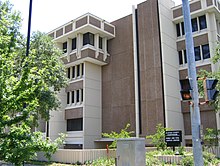Alachua County
| Alachua County, Florida | |||
|---|---|---|---|

Alachua County Courthouse
|
|||
|
|||
 Location in the U.S. state of Florida |
|||
 Florida's location in the U.S. |
|||
| Founded | February 29, 1824 | ||
| Named for | Chua (Timucuan word for "sinkhole") | ||
| Seat | Gainesville | ||
| Largest city | Gainesville | ||
| Area | |||
| • Total | 969 sq mi (2,510 km2) | ||
| • Land | 875 sq mi (2,266 km2) | ||
| • Water | 94 sq mi (243 km2), 9.7% | ||
| Population (est.) | |||
| • (2016) | 263,496 | ||
| • Density | 301/sq mi (116/km²) | ||
| Congressional district | 3rd | ||
| Time zone | Eastern: UTC-5/-4 | ||
| Website | www |
||
Coordinates: 29°41′N 82°22′W / 29.683°N 82.367°W
Alachua County (/əˈlætʃu.ə/ a-LATCH-oo-a) is a county in the U.S. state of Florida. As of the 2010 census, the population was 247,336. The county seat is Gainesville, the home of the University of Florida.
Alachua County is included in the Gainesville, FL Metropolitan Statistical Area. The county is known for its diverse culture, local music, and artisans. Much of its economy revolves around the university.
The first people known to have entered the area of Alachua County were Paleo-Indians, who left artifacts in the Santa Fe River basin prior to 8000 BCE. Artifacts from the Archaic period (8000 - 2000 BCE) have been found at several sites in Alachua County. Permanent settlements appeared in what is now Alachua County around 100 CE, as people of the wide-ranging Deptford culture developed the local Cades Pond culture. The Cades Pond culture gave way to the Alachua culture around 600 CE. The Timucua-speaking Potanos lived in the Alachua culture area in the 16th century, when the Spanish entered Florida. The Potano were incorporated in the Spanish mission system, but disease, rebellion, and raids by tribes backed by the English led to severe population declines and the depopulation of what is now Alachua County by the early 18th century.
...
Wikipedia


